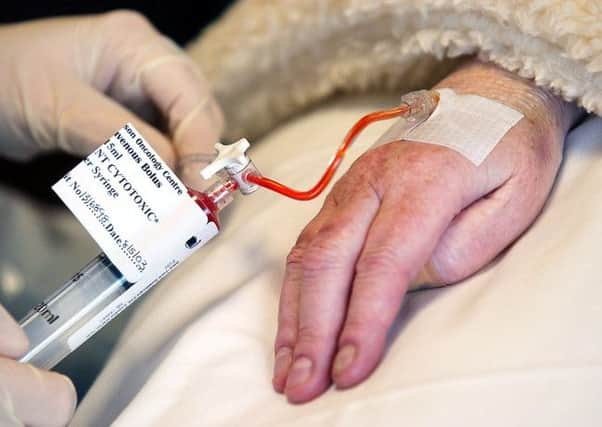Scots hospitals still missing key cancer target


The latest figures show that 92.9 per cent of cancer patients started treatment within two months of being urgently referred with suspicion of the disease between April and June, against a “standard” of 95 per cent.
While there was some improvement on the previous quarter, when 91.5 per cent were seen within the timeframe, campaigners expressed concern that treatment times was still being missed.
Advertisement
Hide AdAdvertisement
Hide AdThe last time the standard was met was October to December 2012.
The figures also revealed that the 62-day target was missed by nine of Scotland’s 14 health boards, and for eight out of 10 cancer types between 1st April and 30th June.
Earlier this year the Scottish Government announced that a special support team would be sent into boards to help improve cancer waiting times after repeated target failures.
Then in June £2.5 million was invested to increase diagnostic and treatment capacity in health boards.
The worst-performing board against the 62-day target was NHS Grampian, with 89.7 per cent of patients seen in this time. This was followed by NHS Greater Glasgow and Clyde at 90.7 per cent.
Only breast (97.8 per cent) and melanoma (97.3 per cent) patients hit the standard. Performance fell as low as 85 per cent for urology cancer, which includes prostate and bladder cancer.
Another target - that 95 per cent of patients should wait no more than 31 days from the decision to treat their cancer to receiving their first treatment - was met, with 96.3 per cent seen in this time, up slightly from 96.2 per cent the previous quarter.
However, the target was missed by NHS Grampian, at 93.5 per cent, and NHS Greater Glasgow and Clyde at 94.1 per cent
Advertisement
Hide AdAdvertisement
Hide AdHealth Secretary Alex Neil welcomed the improvement in performance in some areas, but warned that more work must be done to continue to cut waiting times.
“The Scottish Government has set a very clear standard for health boards that 95 per cent of patients must start cancer treatment within 62 days from first referral on suspicion of cancer and within 31 days from a decision to treat,” he said.
“We immediately recognised earlier this year that performance in some health boards was not where is should be and implemented a support team to help boards ensure no patient waited unnecessarily for treatment.
“Since March this team have been closely monitoring health boards’ performance and immediately acting where problems are identified.
“They have visited health boards and supported them to make the changes needed to reduce waiting times, as well as facilitating a sharing of best practice among the country’s health boards.
“This decisive action, coupled with a £2.5 million investment in June to build diagnostic and treatment capacity, is now starting to show real improvements in waiting times.
“This quarter’s figures indicate we are moving in the right direction towards meeting the 62-day standard in the majority of boards.
“However there is clearly still more work to be done and with an increasing number of people being diagnosed with cancer putting pressure on our services, we will continue to support boards to help make further improvements.”
Advertisement
Hide AdAdvertisement
Hide AdElspeth Atkinson, director of Macmillan Cancer Support in Scotland, expressed concern about the latest cancer treatment statistics.
“It is incredibly disappointing to see cancer waiting times being missed again,” she said.
“The earlier people are diagnosed, the sooner they can be treated and the better their longer-term survival chances.
“These waiting times targets need to be met to ensure the best outcomes for all cancer patients.”
SEE ALSO: